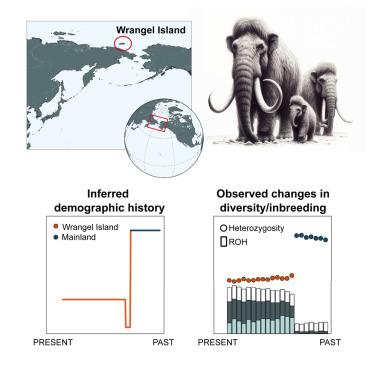Cell ( IF 45.5 ) Pub Date : 2024-06-27 , DOI: 10.1016/j.cell.2024.05.033 Marianne Dehasque , Hernán E. Morales , David Díez-del-Molino , Patrícia Pečnerová , J. Camilo Chacón-Duque , Foteini Kanellidou , Héloïse Muller , Valerii Plotnikov , Albert Protopopov , Alexei Tikhonov , Pavel Nikolskiy , Gleb K. Danilov , Maddalena Giannì , Laura van der Sluis , Tom Higham , Peter D. Heintzman , Nikolay Oskolkov , M. Thomas P. Gilbert , Anders Götherström , Tom van der Valk , Sergey Vartanyan , Love Dalén

|
A number of species have recently recovered from near-extinction. Although these species have avoided the immediate extinction threat, their long-term viability remains precarious due to the potential genetic consequences of population declines, which are poorly understood on a timescale beyond a few generations. Woolly mammoths (Mammuthus primigenius) became isolated on Wrangel Island around 10,000 years ago and persisted for over 200 generations before becoming extinct around 4,000 years ago. To study the evolutionary processes leading up to the mammoths’ extinction, we analyzed 21 Siberian woolly mammoth genomes. Our results show that the population recovered quickly from a severe bottleneck and remained demographically stable during the ensuing six millennia. We find that mildly deleterious mutations gradually accumulated, whereas highly deleterious mutations were purged, suggesting ongoing inbreeding depression that lasted for hundreds of generations. The time-lag between demographic and genetic recovery has wide-ranging implications for conservation management of recently bottlenecked populations.
中文翻译:

猛犸象灭绝前基因组侵蚀的时间动态
许多物种最近从濒临灭绝的状态中恢复过来。尽管这些物种避免了立即灭绝的威胁,但由于种群数量下降的潜在遗传后果,它们的长期生存能力仍然不稳定,而在几代人之后的时间尺度上,人们对此知之甚少。猛犸象 (Mammuthus primigenius) 大约 10,000 年前在弗兰格尔岛上与世隔绝,并持续存在了 200 多代,直到大约 4,000 年前灭绝。为了研究导致猛犸象灭绝的进化过程,我们分析了 21 个西伯利亚长毛猛犸象的基因组。我们的研究结果表明,人口从严重的瓶颈中迅速恢复,并在随后的六千年中保持人口稳定。我们发现,轻度有害的突变逐渐积累,而高度有害的突变则被清除,这表明近交衰退持续了数百代。人口统计和遗传恢复之间的时间滞后对于最近遇到瓶颈的种群的保护管理具有广泛的影响。






































 京公网安备 11010802027423号
京公网安备 11010802027423号